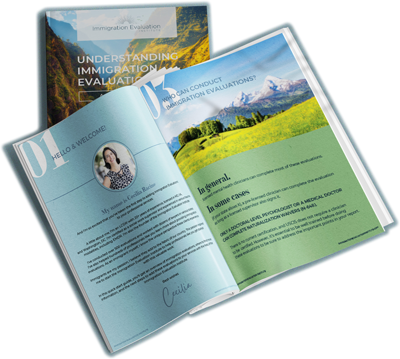What do you want to learn more about?
How to Let Go of the Results of your Immigration Clients’ Cases

As immigration evaluation therapists, we hope that the psychosocial evaluations we prepare will make a significant positive difference to our clients’ futures.
While we may sometimes be lucky enough to learn the outcome of our clients’ cases—such as via a note from an attorney or a thank-you card—other times, life continues to roll on without any updates.
More often than not, we will never learn the outcome of the cases we take on.
In this week’s blog post, we’ll help you understand whether you are someone who may find it difficult to let go of the results of your evaluations and give you some strategies to get comfortable with this lack of closure.
Considering Your Attachment Style
As clinicians, it’s vitally important to be aware of your own attachment style (Fermata Psychotherapy, 2018). This is because our attachment style dictates how we relate to and interpret our clients’ subjective experiences.
Likewise, as immigration evaluation therapists, an understanding of our attachment style can help us make sense of our reactions to the evaluation process.
If it’s been a while since you’ve picked up your psychology textbook, here’s a quick recap on the theory.
Attachment theory argues that how we relate to our primary caregivers as children affects how we relate to others as adults (Howe, 2011). Secure bonds with emotionally available caregivers tend to produce secure attachments in children, whereas more turbulent relationships with caregivers tend to produce insecure attachments.
These types of attachments (and how they play out in the therapeutic context) are as follows:
Secure
The therapist has a history of warm, responsive interactions with caregivers and is thus able to access a wide range of experiences in themselves, be mindful of their own feelings, ideas, and bodily reactions.
Anxious-preoccupied
The therapist seeks approval from others. Consequently, they may over-identify with their clients, avoid conflict, or have difficulties setting boundaries.
Dismissive-avoidant
The therapist tends to resist closeness and hide emotions. Consequently, they will tend to avoid emotional vulnerability with their clients and focus on thoughts rather than feelings.
Anxious-avoidant
The therapist has mixed feelings about emotional vulnerability. Consequently, they will find themselves fluctuating between victim and rescuer roles (Fermata Psychotherapy, 2018).
Knowing your attachment style can help you understand your likely reactions to the termination of the therapist-client relationship that comes with conducting psychosocial evaluations.
Therapists with anxious attachment styles will be more vulnerable to distress following the termination of the relationship, which may make detaching yourself from the outcome more difficult (Zur Institute, 2014). For instance, you may find yourself worrying about the client or revisiting what you wrote for them long after the evaluation process is over.
Strategies to Let Go
Here are some steps you can take to help make letting go of the results easier.
Practice an Alternative Attachment Style
If you find yourself being overly concerned with the outcome of your client’s case, ask yourself this: How would someone with a dismissive attachment style move on from this result?
If you find yourself getting overwhelmed with uncertainty about an outcome, practice cognitively reframing the situation as though you were someone with a more dismissive attachment style. This may mean thinking to yourself, “It’s only a job.”
While this is not a message we necessarily want to take to heart, practicing this alternative way of thinking may serve as a steppingstone to help you find balance between the emotional authenticity of an anxious attachment style and the pragmatism of a dismissive style (Shorey, 2019).
Address Termination Issues from the Outset
The American Psychological Association generally advises against providing ongoing therapy for a client to whom you also provide a psychosocial evaluation. This is because doing so may be perceived as a conflict of interest.
Establishing this expectation with your client from the outset (and providing them with a referral or recommendation should they need ongoing support) can not only help your client plan their next steps following the evaluation but help you create psychological distance following the end of the therapeutic relationship.
Give Every Evaluation 100%
If you’re preparing quality evaluations every time, you can rest assured knowing that you’ve done the best you can to help bring about a positive outcome for your client. After that, you can rest easier knowing the outcome is now out of your hands.
Closing Thoughts…
While letting go of the results of your evaluations may be hard, here’s some good news.
In 2015 the nonprofit and provider of psychosocial evaluations, Physicians for Human Rights, reported that of the 540 or so evaluations they prepared, a favorable outcome for the client was granted in about 90% of cases. This compares to a national application acceptance rate of just 48% that same year (Boodman, 2017).
This means you can feel comfortable in the knowledge that, odds-wise, you’ve most likely had the positive impact you were hoping for. So sleep soundly!
References
Boodman, E. (2017, January 25). Fleeing violence, asylum-seekers rely on psychologists to back up their story. Stat Special Report.
Fermata Psychotherapy. (2018). The importance of the therapist’s attachment style.
Howe, D. (2011). Attachment across the lifecourse. London, UK: Palgrave.
Shorey, H. (2019). Overcome anxious attachment by becoming dismissive. Psychology Today.
Zur Institute. (2014). Clients’ attachment styles & therapy outcomes.

I’m Cecilia Racine, and I teach therapists how to help immigrants through my online courses. As a bilingual immigrant myself, I know the unique perspective that these clients are experiencing. I’ve conducted over 500 evaluations and work with dozens of lawyers in various states. Immigrants are my passion, I believe they add to the fabric of our country.
related articles
Helping Immigrants Find Safety and Healing Through U and T Visas
As mental health clinicians, we possess a unique set of skills that can be a…
Expand Your Expertise: Recommended Trainings for Immigration Clinicians
The Immigration Evaluation Institute Comprehensive course is a great first step into the world of…
Ethical Considerations in Immigration Evaluations
The role of mental health professionals in immigration evaluations is fraught with unique ethical complexities.…
Join the Free
Immigration evaluation
therapists facebook group
Are you a therapist that conducts immigration evaluations?



